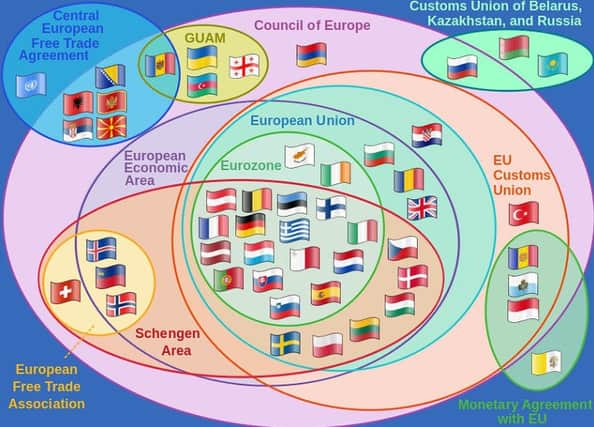POLITICALLY SPEAKING: Alex Story outlines and explains terms relating to the EU, trade and Brexit


The European Union:
The EU is essentially a group of European nations, including the UK, bound in a customs union, where the EU negotiates international trade arrangements on behalf of its members. The 28 members are also engaged in convergence of trade and other regulations so as to eliminate issues on standards.
European Free Trade Association (EFTA)
A trade bloc, of which the UK was one of the founders, but which we left in 1973 to join the EU. Its members are now just Switzerland, Norway, Iceland and Lichtenstein although it once included Austria, Sweden, Denmark Portugal and other countries, which also left to join the EU.
The Single Market
Advertisement
Hide AdAdvertisement
Hide AdA consequence of an agreement between the 28 EU countries, which are full members of the customs union, and three members of the European Free Trade Association. There are 31 members of the single market able to trade freely between each other. All EU members are in the single market but not all single market members are in the EU. If the UK was to remain in the single market it could still be outside of the EU.
The European Economic Area (EEA)
The European Economic Area or EEA is essentially the single market. It is made up of the 28 EU states and three of the four EFTA members. To be in the single market you must be a member of either the EU, or EFTA, and you must sign the EEA agreement. Switzerland, although an EFTA member, hasn’t signed the EEA agreement and relies upon a series of bi-lateral trade agreements between it and the EU countries, and its EFTA membership for trade with other EFTA countries.
The Eurozone
An area of EU countries with the Euro as their official currency. This requires them to surrender control of their currency to the Europe Central Bank. The UK is not a member, neither is Sweden, Poland or Denmark which retained their own money.
Hard Brexit
This means leaving the EU and severing ties with the single market by revoking our membership of the EEA. If we attempt to do this we would have to trade under what are known as World Trade Organisation rules. This would mean tariffs on motor vehicles, for example, equivalent to what the EU charges other WTO countries (typically 10 per cent). Unless we can sign a trade agreement with the EU.
Soft Brexit
Advertisement
Hide AdAdvertisement
Hide AdThis is essentially where the UK leaves the EU customs union but remains in the EEA by becoming members of EFTA and retaining full access to the single market. It has its disadvantages because we would have to obey EU rules relating to the single market (about 27% of what we do now), the truth is that these are quite often global regulations that we would have to obey anyway, as WTO members.
Please see the Euler diagram (pronounced oyler), for a fuller explanation of who is in what.